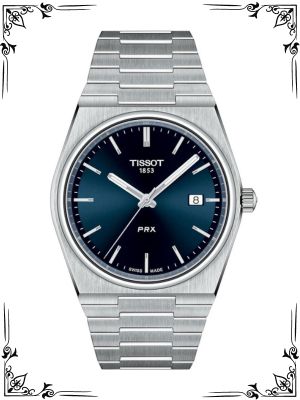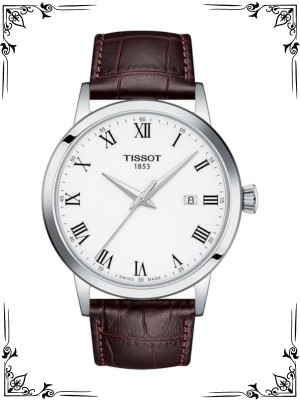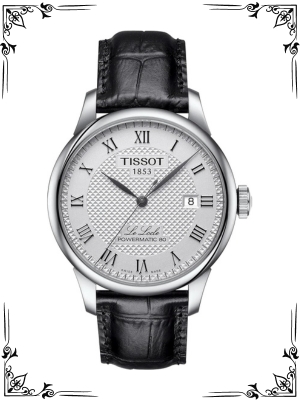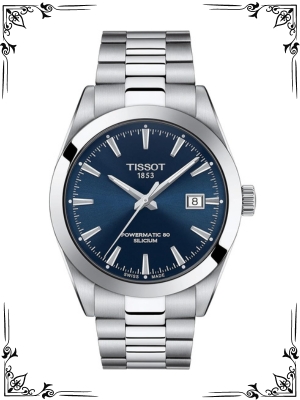Porsamo Bleu caters to a budget-conscious audience. They offer fashion-oriented watches with basic functionalities. Tissot, on the other hand, is a renowned Swiss watchmaker with a rich heritage. They offer a wider range of styles, from classic and elegant to sporty and functional, all powered by high-quality Swiss movements.
Introduction
The world of watches offers a vast array of choices, and navigating this landscape can be daunting, especially when brands like Porsamo Bleu and Tissot appear on your radar. Both offer enticing options, but key differences set them apart.
Let’s embark on a journey to understand these brands, their strengths, and weaknesses, helping you choose the perfect timepiece for your wrist.
A Tale of Two Brands: A Look Back in Time
Porsamo Bleu: Information about Porsamo Bleu’s origins is scarce. They appear to be a relatively new brand, primarily focusing on online sales through retailers like The Bay in Canada. While the lack of a long history might raise questions, it also allows them to focus on offering trendy designs at competitive prices.
Tissot: Founded in 1853 by Charles-Félicien Tissot in Le Locle, Switzerland, Tissot boasts a rich heritage in Swiss watchmaking. They are renowned for their innovative spirit and commitment to quality.
Over the years, Tissot has achieved several milestones, including being the official timekeeper for various sporting events like the Tour de France and the NBA. Their legacy speaks volumes about their dedication to the art of watchmaking.
Technical Breakdown: Unveiling the Inner Workings
Let’s delve into the technical aspects of Porsamo Bleu and Tissot watches to understand their core functionalities:
Movement
Porsamo Bleu: Primarily utilizes quartz movements. Quartz movements are known for their accuracy and affordability, making them a suitable choice for those seeking a reliable timepiece without breaking the bank. However, some Porsamo Bleu models might use less reputable quartz movements, potentially impacting long-term reliability.
Tissot: Offers a wider range of movements. Their core collection predominantly features Swiss quartz movements, ensuring precision timekeeping. However, Tissot also boasts a prestigious line of automatic mechanical movements, known for their intricate engineering and heritage.
These automatic watches are powered by your natural movements, eliminating the need for battery changes but requiring occasional servicing.
Materials and Construction
Porsamo Bleu: Focuses on materials that keep costs down. Stainless steel is a common choice for cases, but some models might utilize alloy metals or plastic. Leather straps and silicone bands are prevalent options. While these materials offer affordability, they might not be as durable or luxurious as some higher-end options.
Tissot: Emphasizes quality construction. Stainless steel remains a popular choice for their cases, but they also offer models crafted from higher-grade materials like titanium and ceramic. Leather straps are often of superior quality, and some models feature exotic leather or high-end metal bracelets.
Functions and Features
Porsamo Bleu: Prioritizes basic timekeeping functionalities. Most models offer features like date windows and water resistance. However, complex features like chronographs or multiple subdials are uncommon.
Tissot: Provides a wider variety of functionalities. Their core collection offers basic timekeeping features like Porsamo Bleu, but Tissot also boasts a diverse range of watches with additional functionalities.
These include chronographs for measuring elapsed time, tachymeters for calculating speed, multiple subdials for displaying additional time zones or other functions, and even complicated mechanical movements with features like perpetual calendars and moon phases.
Here’s a table summarizing the key technical differences:
| Feature | Porsamo Bleu | Tissot |
|---|---|---|
| Movement | Primarily Quartz | Swiss Quartz, Automatic |
| Materials | Stainless Steel, Alloy | Stainless Steel, Higher- |
| (might use), Plastic | Grade Materials | |
| Construction | Focus on Affordability | Emphasis on Quality |
| Functions and Features | Basic Timekeeping | Wide Range, Complexities |
Design and Aesthetics: A Matter of Personal Preference
Both Porsamo Bleu and Tissot cater to distinct design sensibilities. Let’s explore what each brand brings to the table:
Dial Design
Porsamo Bleu: Embraces trendy aesthetics. Bold colors, oversized numerals, and skeletonized (but non-functional) elements are often incorporated. These dials are designed to make a statement and appeal to those who prioritize a fashion-forward look. However, some might find the designs busy or lacking in classic elegance.
Tissot: Offers a diverse range of dial styles. Their collection includes classic and minimalist designs with clean lines and simple markers, perfect for those who appreciate timeless elegance. They also cater to sportier tastes with chronographs and multi-dial layouts that prioritize functionality.
Tissot offers a wider variety of color options, from traditional black and white to bolder hues, allowing you to personalize your timepiece.
Case and Bracelet
Porsamo Bleu: Focuses on affordability. Stainless steel cases are common, but some models might utilize alloy metals or plastic to keep costs down. Leather straps and silicone bands are prevalent options, offered in various colors to complement the dial design. While these materials offer a variety of choices, they might not exude the same level of sophistication as some higher-end options.
Tissot: Emphasizes quality and variety. Stainless steel remains a popular choice for their cases, but they also offer models crafted from higher-grade materials like titanium and ceramic, known for their lightness, durability, and scratch resistance. Leather straps are often of superior quality, with some models featuring exotic leather like alligator or crocodile.
High-end metal bracelets are also available, adding a touch of luxury. The overall case and bracelet construction in Tissot watches reflects a focus on quality and durability.
Brand Image
Porsamo Bleu: Projects a trendy and fashion-oriented image. Their focus on affordability and eye-catching designs makes them appealing to a younger audience or those seeking a statement piece without a hefty price tag. However, the lack of brand heritage and focus on basic functionalities might not resonate with those who value tradition and intricate watchmaking.
Tissot: Embodies a legacy of Swiss watchmaking excellence. Their rich history, commitment to quality, and association with sporting events like the Tour de France cultivate a brand image that is both sophisticated and reliable.
Tissot offers a wider range of styles, catering to diverse preferences while maintaining a reputation for high-quality construction and reliable movements.
Ultimately, the choice in design comes down to your personal taste. Do you crave a trendy and eye-catching piece, or do you prioritize a classic and timeless aesthetic with a touch of luxury? Consider your lifestyle and the message you want your watch to convey when making your decision.
Here’s a table summarizing the key design and aesthetic differences:
| Feature | Porsamo Bleu | Tissot |
|---|---|---|
| Dial Design | Trendy, Bold Colors | Diverse, Classic & Sporty |
| Case and Bracelet | Affordable Materials | Quality Materials, Variety |
| Brand Image | Trendy, Fashion-Oriented | Swiss Heritage, Reliable |
User Feedback: The Voice of Experience
Before making your final decision, it’s valuable to consider user experiences with both Porsamo Bleu and Tissot watches. Here’s a breakdown of some common feedback:
Porsamo Bleu
Positives: Users appreciate the trendy designs and affordable prices. The lightweight nature of some models makes them comfortable for everyday wear. For those seeking a basic timepiece with a fashionable aesthetic, Porsamo Bleu offers a viable option.
Negatives: Some users report concerns about long-term durability due to the use of potentially less-reputable quartz movements and less robust materials. The fashion-forward designs might not appeal to everyone, and some might find them lacking in classic elegance.
Tissot
Positives: Users consistently praise the high quality of Tissot watches. The Swiss movements ensure reliable timekeeping, and the use of superior materials guarantees durability. The wide range of styles allows users to find a watch that perfectly complements their taste and lifestyle.
Negatives: Tissot watches, especially those with automatic movements, come at a higher price point compared to Porsamo Bleu. The complex functionalities of some Tissot models might be overwhelming for users who simply need a basic timepiece.
Common Problems: Potential Challenges to Consider
While both Porsamo Bleu and Tissot offer compelling options, it’s essential to be aware of potential challenges:
Porsamo Bleu:
- Limited Warranty: Warranty information for Porsamo Bleu watches might be limited, potentially leading to higher repair costs in case of issues.
- Battery Replacement: Quartz movements require periodic battery changes, which adds a recurring cost. The quality of the quartz movement can impact battery life.
- Durability Concerns: The use of less robust materials might raise concerns about the watch’s ability to withstand everyday wear and tear.
Tissot:
- Higher Cost: As a renowned Swiss watchmaker, Tissot watches come at a premium compared to Porsamo Bleu.
- Automatic Movement Maintenance: Automatic movements require periodic servicing, which can be more expensive than battery changes for quartz movements.
- Complex Functions: While some users appreciate the additional functionalities on some Tissot models, others might find them overwhelming or unnecessary.
The Final Lap: Choosing Your Champion
By now, you have a comprehensive understanding of the key differences between Porsamo Bleu and Tissot watches. Here are some key questions to ask yourself before making your final decision:
Budget: Consider how much you’re comfortable spending on a watch. Tissot offers high quality but comes at a higher price point.
Style: Do you crave a trendy and eye-catching design, or do you prefer a classic and timeless aesthetic?
Functionality: How important are additional functionalities beyond basic timekeeping? Tissot offers a wider range of complex features.
Lifestyle: Consider your daily activities. If you lead a very active lifestyle, a Tissot with a robust build might be a better choice.
Ultimately, the best choice depends on your individual needs and preferences. If you prioritize affordability and a trendy design, Porsamo Bleu could be a good option. But if you value quality, a legacy of Swiss watchmaking, and a wider range of styles and functionalities, Tissot might be the better fit.
Conclusion
The world of watches offers a captivating array of choices, and both Porsamo Bleu and Tissot have something to offer. By understanding their unique strengths and weaknesses, you can make an informed decision and select the perfect timepiece to adorn your wrist.
Remember, a watch is more than just a tool for telling time; it’s a reflection of your style and personality. So, choose wisely and wear your timepiece with pride!
FAQs
1. Are Porsamo Bleu watches good quality?
Porsamo Bleu prioritizes affordability and trendy designs. While they utilize quartz movements for reliable timekeeping, the overall quality can vary depending on the model. The use of potentially less robust materials like alloy metals or plastic might raise concerns about long-term durability, especially when compared to Tissot’s focus on high-grade materials.
2. Is Tissot a luxury watch brand?
Tissot positions itself in the upper echelon of affordable luxury watches. They offer a significant step up from fashion watch brands by using high-quality Swiss movements and superior materials like stainless steel and sapphire crystal.
However, they remain distinct from high-end watchmakers known for intricate complications and the use of precious metals like platinum. Tissot strikes a balance between affordability and quality.
3. Where can I buy Porsamo Bleu and Tissot watches?
Here are several options to consider:
- Authorized Retailers: Both brands have authorized retailers that provide a curated selection of watches and expert advice. Visiting an authorized retailer allows you to try on the watches, ask questions, and gain valuable insights before making a purchase.
- Online Retailers: Several reputable online retailers offer both Porsamo Bleu and Tissot watches. This can be a convenient option, but ensure the retailer is trustworthy and offers secure payment methods with clear return policies.
4. Should I choose a Porsamo Bleu or Tissot watch based on my lifestyle?
Absolutely! Consider your daily activities. If you lead a very active lifestyle, a Tissot with a robust build and high-quality materials might be a better choice for long-term wear and tear. Porsamo Bleu’s focus on affordability might be suitable for those seeking a more casual timepiece.
5. What if I’m on a tight budget?
Porsamo Bleu is a great option for budget-conscious watch buyers. They offer a variety of trendy styles at affordable prices. However, if you can slightly stretch your budget and prioritize long-term quality and a wider range of styles and functionalities, Tissot might be a worthwhile investment.





